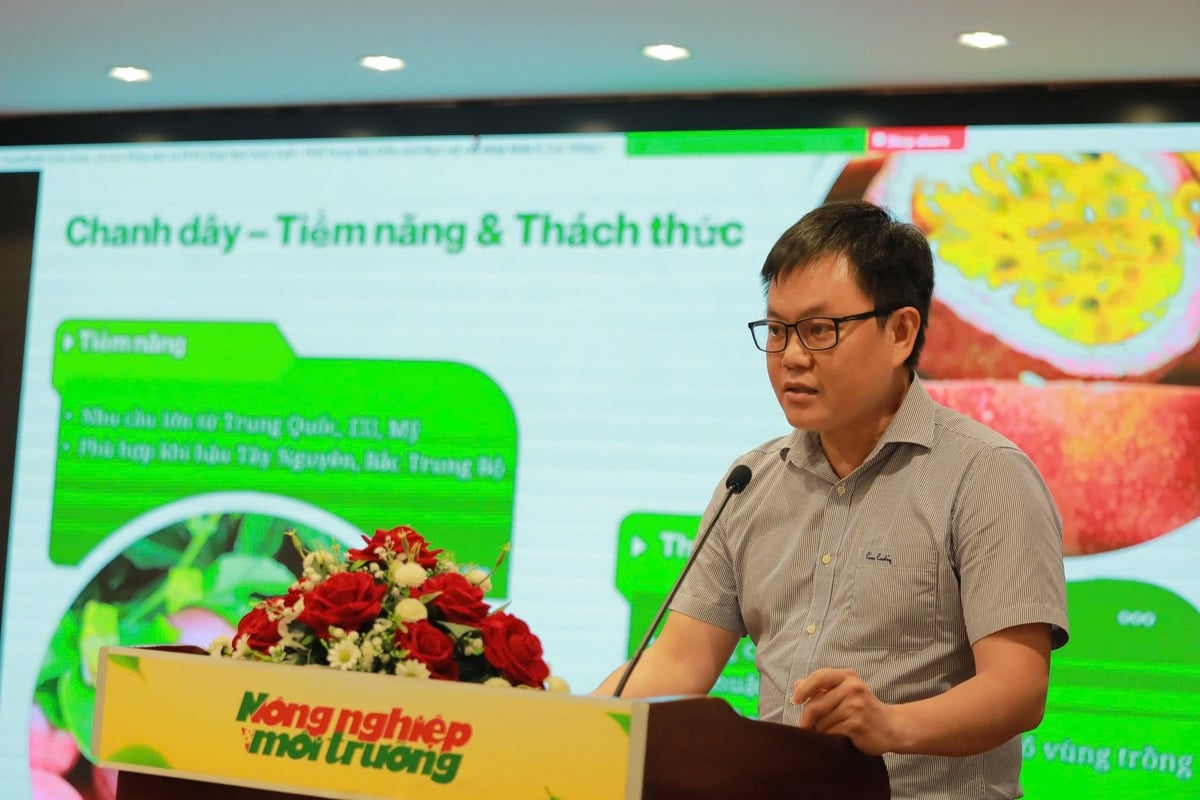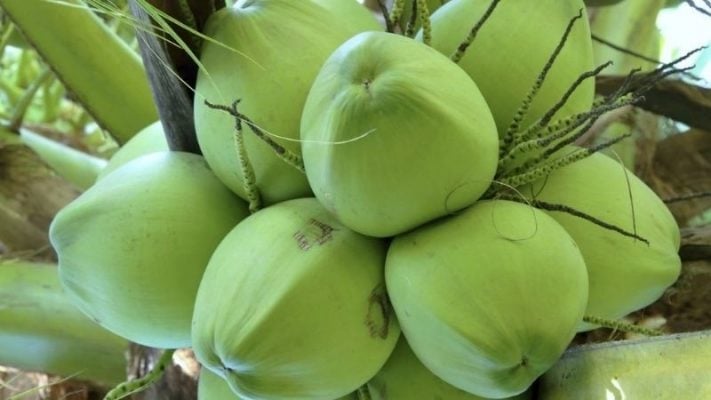December 31, 2025 | 04:14 GMT +7
December 31, 2025 | 04:14 GMT +7
Hotline: 0913.378.918
December 31, 2025 | 04:14 GMT +7
Hotline: 0913.378.918
Ho Chi Minh City on the morning of July 18, 2025, hosted a forum on "Solutions to enhance competitiveness and promote export of key fruit products: passion fruit, banana, pineapple, coconut." In his keynote address, MSc. Ngo Quoc Tuan, Deputy Director of the Plant Protection Department's Center for Post-Import Plant Quarantine II, outlined a comprehensive picture of current production, development orientations until 2030, and the efforts and challenges in opening international markets for these fruits.
In 2024, Vietnam's passion fruit production reached 163.4 thousand tons across 10.4 thousand hectares of cultivated land, with the Central Highlands being the main hub (151.3 thousand tons). By 2030, the cultivated area is projected to increase to 12-15 thousand hectares, with an output of 250-300 thousand tons, focusing on provinces like Lam Dong, Dak Nong, and Gia Lai. The agricultural sector will prioritize researching high-quality, disease-resistant new varieties and developing clean seedling systems.

MSc. Ngo Quoc Tuan, , Deputy Director of the Plant Protection Department's Center for Post-Import Plant Quarantine II sharing at the forum. Photo: Nguyen Thuy.
The US market is very close to opening for Vietnamese passion fruit. Both sides have completed their reports and are awaiting the USDA to post the final public comment notice. In addition to the already accepted irradiation method, Vietnam is proposing hot vapor treatment to further facilitate exports for businesses. Technical dossiers for export to South Korea have also been submitted and are under pest risk analysis. With 70-80% of current production already exported, Vietnamese passion fruit needs to focus on quality to maintain and increase its value in the global market.

A crucial strategy involves staggered pineapple planting (30-40% of the area) to ensure year-round supply for processing and fresh markets. Photo: Tung Dinh.
Pineapple production reached 860 thousand tons across 52 thousand hectares in 2024, with the Mekong Delta leading. This product has already been exported to 122 countries. The goal for 2030 is 55-60 thousand hectares and an output of 800-950 thousand tons. Ninh Binh, Thanh Hoa, Quang Nam, Tien Giang, and Kien Giang will be key provinces. A crucial strategy involves staggered pineapple planting (30-40% of the area) to ensure year-round supply for processing and fresh markets, while leveraging the EVFTA to boost exports to the EU market (UK, Germany, Switzerland).
Banana is a key fruit, with 3 million tons produced from 161 thousand hectares in 2024. China is the largest importer of Vietnamese bananas, accounting for nearly 625.25 thousand tons in 2024. Vietnamese bananas are also present in South Korea, Japan, ASEAN, the EU, and the Middle East.
MSc. Ngo Quoc Tuan emphasized that banana exports now depend less on market expansion and more on enhancing product quality. The orientation for 2030 is 165-175 thousand hectares and an output of 2.6-3 million tons. The banana industry needs to continuously improve quality, diversify designs, strictly control production processes, and build strong brands to increase value and maintain its position in international markets.
With 202 thousand hectares and 2.28 million tons of production in 2024, coconut is the largest cultivated crop in this group, with the Mekong Delta dominating. Vietnam is one of the world's leading coconut exporters, with products reaching China, the US, the EU, Japan, South Korea, and Canada.

An important solution involves intercropping and integrated farming to increase land value, along with integrating garden ecotourism, developing craft villages, and OCOP products. Photo: TL.
By 2030, the coconut area is projected to remain around 195-210 thousand hectares, focusing on the Mekong Delta and South Central Coast. The coconut industry will transfer new varieties (Xiêm xanh bầu, Malaysian, Pineapple coconut), promote GAP-compliant production, and aim for 30% of the area to be granted planting area codes. An important solution involves intercropping and integrated farming to increase land value, along with integrating garden ecotourism, developing craft villages, and OCOP products. Investing in deep processing and brand building is crucial to limit raw material exports and enhance the value of Vietnamese coconuts.
Opening fresh agricultural product markets is always a complex and lengthy process due to phytosanitary and food safety requirements. Importing markets are continuously adding stricter control measures, especially after incidents of phytosanitary and food safety violations led to the revocation of some planting area codes and packing facilities (e.g., durian, jackfruit), directly impacting trade.
Accessing new markets is not simple. Some South American countries impose "reciprocal" market access conditions, demanding Vietnam complete Pest Risk Analyses (PRA) for their products first. Furthermore, long distances and high transportation costs make competition more challenging compared to rivals like Peru, Ecuador, Mexico, or Colombia. Even the ASEAN market, despite its proximity, poses challenges as regional countries share similar climates and soil conditions, leading to tough competition with domestic products.
Nevertheless, these challenges also present an opportunity for Vietnam's agricultural sector to focus on depth, enhance product quality, apply advanced technology, and build strong brands. Only by comprehensively overcoming these hurdles can Vietnam's key fruits achieve a breakthrough, affirm a sustainable position in international markets, and bring higher value to farmers.
"To export well, we must excel in traceability and supply chain linkages, where each enterprise, cooperative, and farming household becomes a crucial link in ensuring transparency and safety throughout the entire export value chain," Tuan stated.

(VAN) Located in three former provinces, Nam Dinh, Thai Binh, and Ninh Binh, and now in two provinces, Ninh Binh and Hung Yen, "Red River Delta" is the name of Vietnam's first interprovincial coastal wetland World Biosphere Reserve.
/2025/12/29/1046-1-210728_624.jpg)
(VAN) In 2025, Viet Nam recorded severe and extreme disasters, breaking multiple historical records and causing heavy losses in lives, property, and infrastructure nationwide.

(VAN) Applied technologies, water-saving irrigation is a strategic solution to promote climate-resilient agriculture and strengthen water security in the uplands.
/2025/12/29/3936-3-163422_251.jpg)
(VAN) Can Gio mangrove forest in particular and the entire Can Gio Mangrove Biosphere Reserve in general hold great potential for carbon credits.

(VAN) Chu Pah Rubber has announced its products that comply with the EU Deforestation Regulation (EUDR), affirming its commitment to sustainable production and product origin transparency.

(VAN) Deputy Director Nguyen Hoai Nam stated that a digital data platform will be developed with agricultural sector databases, utilizing AI to help farmers make informed decisions on 'watering correctly, sufficiently, and efficiently.’
/2025/12/29/4841-2-134224_777.jpg)
(VAN) From only about 10 individuals in 2009, the wild elephant population in Dong Nai has recovered to nearly 30 animals after more than 10 years.